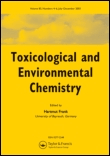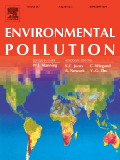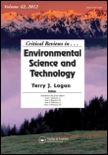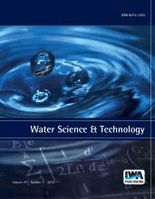
Journal of Environmental Health Science and Engineering
Scope & Guideline
Pioneering research for a healthier, more sustainable future.
Introduction
Aims and Scopes
- Environmental Pollutants and Health Risks:
The journal focuses on the assessment and management of environmental pollutants, including heavy metals, air pollutants, and organic micropollutants, and their associated health risks to humans and ecosystems. - Innovative Treatment Technologies:
Research on novel and advanced treatment technologies for wastewater, air quality improvement, and pollutant removal is a core area, emphasizing the development of cost-effective and efficient methods. - Sustainable Practices and Resource Recovery:
The journal promotes research on sustainable practices such as waste valorization, bioremediation, and the recovery of resources from waste materials, highlighting the importance of circular economy approaches. - Microbial and Biochemical Processes:
Studies investigating microbial processes for environmental remediation and pollutant degradation, as well as the biochemical mechanisms involved, are a significant focus. - Public Health and Environmental Interactions:
The journal explores the links between environmental factors and public health outcomes, including epidemiological studies that assess the impact of environmental exposures on health. - Modeling and Predictive Analysis:
Utilization of modeling techniques, including artificial intelligence and statistical methods, to predict environmental quality and assess the efficacy of interventions is a recurring theme.
Trending and Emerging
- Microplastics Research:
There has been a significant uptick in studies addressing the presence, impact, and removal of microplastics in various environmental contexts, signaling increased awareness and regulatory focus on this issue. - Artificial Intelligence and Machine Learning Applications:
The application of AI and machine learning for modeling environmental data and predicting health outcomes is emerging as a prominent trend, reflecting advancements in computational technology. - Integrated Wastewater Management Solutions:
Research focusing on integrated approaches to wastewater management, including resource recovery and treatment efficiency, is gaining momentum, indicating a shift towards more sustainable practices. - Health Impact Assessments Related to Air Quality:
Increasing attention is being paid to the health impacts of air pollution, particularly in urban settings, as evidenced by systematic reviews and epidemiological studies that link air quality to health outcomes. - Sustainable Materials and Green Chemistry:
There is a growing interest in sustainable materials and green chemistry approaches for pollution mitigation, with studies exploring biodegradable materials and eco-friendly remediation technologies.
Declining or Waning
- Traditional Chemical Analysis Methods:
There is a noticeable reduction in the publication of studies solely focused on traditional chemical analysis methods for environmental samples, as newer technologies and methodologies gain traction. - Single-Contaminant Focus Studies:
Research concentrating exclusively on single contaminants is becoming less common, with a growing emphasis on multicomponent systems and interactions between various pollutants. - General Environmental Awareness Studies:
Papers that broadly address environmental awareness without specific scientific investigation or data analysis are less frequently seen, as the journal increasingly favors data-driven and solution-oriented research.
Similar Journals

ACS Environmental Au
Catalyzing Research for a Greener TomorrowACS Environmental Au is a leading open-access journal published by the American Chemical Society (ACS), dedicated to advancing research in the environmental sciences. Since its inception in 2021, this journal has quickly established itself in the highly competitive landscape of environmental research, achieving Q1 status across multiple categories—Environmental Engineering, Environmental Science (Miscellaneous), and Water Science and Technology. With a strong Scopus ranking, including Rank #38 in Water Science and Technology representing the top 85th percentile, ACS Environmental Au serves as a vital platform for disseminating high-quality research and innovative solutions to pressing environmental challenges. It is particularly notable for its commitment to accessibility, providing researchers, professionals, and students with open access to critical findings that support sustainable development and environmental stewardship. This journal not only emphasizes rigorous scientific inquiry but also seeks to provoke thoughtful discourse and collaborative initiatives that address global environmental issues.

TOXICOLOGICAL AND ENVIRONMENTAL CHEMISTRY
Innovating solutions for a sustainable and healthy future.TOXICOLOGICAL AND ENVIRONMENTAL CHEMISTRY is a pivotal journal published by Taylor & Francis Ltd, addressing critical intersections between environmental chemistry and toxicology since its inception in 1979. With its ISSN 0277-2248 and E-ISSN 1029-0486, the journal serves as a platform for rigorous research and innovative methodologies in pollution control, health implications of environmental chemicals, and the broader spectrum of toxicological studies. Although it currently does not offer open access, the journal's impact in the field is underscored by its Category Quartiles rankings in 2023, placing it in Q3 across Environmental Chemistry, Health, Toxicology and Mutagenesis, and Pollution categories. Furthermore, its Scopus rankings reveal its significant role within the scientific community, specifically in areas such as Environmental Science and Toxicology. The journal aspires to foster multidisciplinary dialogue and advance knowledge that contributes to environmental sustainability and public health, making it an essential resource for researchers, professionals, and students dedicated to these fields.

Air Quality Atmosphere and Health
Innovating Research at the Intersection of Environment and HealthAir Quality, Atmosphere and Health is a leading interdisciplinary journal published by Springer, focusing on the intricate relationship between air quality and public health. With roots dating back to 2008, the journal has established itself as a pivotal resource for researchers and professionals in the fields of Atmospheric Science, Health, Toxicology and Mutagenesis, and Pollution Management and Policy, achieving a commendable Q2 ranking across multiple categories in 2023. The journal’s rigorous peer-review process ensures that it publishes high-quality research that addresses contemporary challenges in air quality management and its impact on health outcomes. With no Open Access option, the journal maintains a model that prioritizes valuable insights for subscription holders, making it an essential reference point for advancing knowledge on environmental health issues. The journal is based in the Netherlands and contributes significantly to the understanding of atmospheric pollutants and their effects, evidenced by its strong Scopus rankings, positioning it in the top percentiles of various environmental science categories.

ENVIRONMENTAL POLLUTION
Pioneering research in toxicology and public health.Environmental Pollution, published by Elsevier Science Ltd, stands at the forefront of research related to environmental contaminants and their effects on health and ecosystems. With an impressive impact factor reflected in its Q1 rankings across various categories including Health, Toxicology, and Pollution, this journal is a pivotal resource for academics and professionals in the fields of environmental science and toxicology. The journal, established in 1973, continues to disseminate high-quality articles that explore the implications of pollution and advance knowledge on toxicological impacts and mitigation strategies. Although it is not an open-access journal, it offers robust visibility within the scientific community, ensuring vital research reaches those who need it most. Researchers, students, and professionals dedicated to understanding and addressing the challenges of environmental pollution will find Environmental Pollution to be an indispensable platform for their work, guiding the ongoing dialogue on sustainable practices and public health protection.

Desalination and Water Treatment
Transforming Water, Enriching LivesDesalination and Water Treatment is a pivotal journal in the realm of water science and technology, focusing on the critical issues surrounding water desalination and treatment processes. Published by DESALINATION PUBL in the United States, this journal, with ISSN 1944-3994 and E-ISSN 1944-3986, serves as an essential resource for researchers, professionals, and students engaged in ocean engineering, pollution control, and innovative water management strategies. With a transitional coverage from 2009 to 2024, it holds a respectable position in the third quartile of various categories, including Ocean Engineering, Pollution, and Water Science and Technology, as of 2023. The journal is indexed in Scopus, reflecting its contribution to the field by ranking within the 39th to 45th percentile across relevant subject areas. Although not an open-access publication, it remains a crucial platform for disseminating influential research, thereby enhancing the global repository of knowledge on water treatment methodologies and sustainable practices in desalination.

Science of The Total Environment
Uncovering Solutions for a Healthier PlanetScience of The Total Environment, an esteemed journal published by Elsevier, holds a significant position in the field of environmental science, encompassing critical areas such as Environmental Chemistry, Environmental Engineering, Pollution, and Waste Management and Disposal. With an impressive impact factor and ranked in the Q1 quartile across its categories for 2023, the journal is recognized for its high-quality research output and contribution to environmental sustainability. Operating from its base in the Netherlands, the journal has been a valuable resource since its inception in 1972, welcoming innovative studies that address complex environmental challenges. Its notable rankings—such as Rank #9 in both Environmental Sciences and Pollution—underscore its relevance and influence in the academic community. Although the journal currently does not provide an open access option, the robust findings and discussions presented within its pages continue to foster a deeper understanding of environmental issues. Science of The Total Environment is an essential platform for researchers, professionals, and students dedicated to advancing knowledge and solutions in the rapidly evolving field of environmental science.

Environmental Health Engineering and Management Journal
Pioneering Research for a Sustainable FutureEnvironmental Health Engineering and Management Journal is a premier platform dedicated to the dissemination of research findings in the essential field of environmental health. Published by Kerman University of Medical Sciences in Iran, this Open Access journal has been a beacon of scientific inquiry since its inception in 2014. With an ISSN of 2423-3765 and E-ISSN 2423-4311, it facilitates broad accessibility to cutting-edge research that addresses the complex interactions between environmental factors and human health. With a notable categorization in the Q3 quartile for Environmental Science and Public Health, alongside Q4 in Chemical Health and Safety, the journal underscores its commitment to quality and relevance. Currently ranked #132 out of 233 in Environmental Science within Scopus, it serves as a crucial resource for researchers and practitioners striving to tackle contemporary environmental challenges. The journal's scope includes innovative methodologies, environmental risk assessment, and sustainable health practices, positioning it as an indispensable reference for those invested in improving public health outcomes through environmental engineering and management.

ENVIRONMENTAL SCIENCE & TECHNOLOGY
Empowering researchers to shape the future of environmental science.ENVIRONMENTAL SCIENCE & TECHNOLOGY, published by the American Chemical Society, is a premier journal dedicated to the rapid dissemination of innovative and impactful research in the fields of environmental science and technology. With an ISSN of 0013-936X and an E-ISSN of 1520-5851, this journal boasts a remarkable Q1 ranking across multiple categories including Chemistry (Miscellaneous), Environmental Chemistry, and Medicine (Miscellaneous) for 2023, reflecting its crucial role in advancing interdisciplinary approaches to pressing environmental issues. Notably, it holds prestigious Scopus rankings, being ranked #26 in General Chemistry and #10 in Environmental Chemistry, placing it in the top portions of its respective categories with unmatched visibility at the 93rd percentile. Spanning a publication history from 1967 to 2024, the journal serves as a vital resource for researchers, professionals, and students aiming to contribute to sustainable solutions and scientific advancements. By prioritizing rigor and relevance, ENVIRONMENTAL SCIENCE & TECHNOLOGY fosters academic dialogue and innovation within these crucial fields, making it an essential read for anyone invested in environmental progress.

CRITICAL REVIEWS IN ENVIRONMENTAL SCIENCE AND TECHNOLOGY
Elevating Standards in Environmental Science and TechnologyWelcome to CRITICAL REVIEWS IN ENVIRONMENTAL SCIENCE AND TECHNOLOGY, an esteemed journal published by Taylor & Francis Inc. This journal has been at the forefront of environmental research since its inception in 1993, spanning a wide range of disciplines including environmental engineering, pollution control, waste management, and water science. CRITICAL REVIEWS holds an impressive Q1 ranking in multiple categories, including Environmental Engineering and Pollution, demonstrating its critical role in advancing knowledge within the field. With a remarkable Scopus ranking—placing it in the top 1% for Environmental Science categories—this journal serves as an invaluable resource for researchers, professionals, and students alike, providing comprehensive reviews and analyses that catalyze innovative solutions to pressing environmental challenges. Though currently not open access, the journal's content is accessible through various academic platforms, ensuring that cutting-edge research is available to a global audience. Join the community of scholars dedicated to enhancing our understanding of environmental science and technology through rigorous investigation and critical discourse.

WATER SCIENCE AND TECHNOLOGY
Advancing sustainable solutions for a vital resource.WATER SCIENCE AND TECHNOLOGY, published by IWA PUBLISHING, is a leading academic journal dedicated to advancing the field of water science and technology. With a rich history dating back to 1970, the journal provides a platform for innovative research and technological advancements, catering to the vital challenges faced within the realms of environmental engineering and water resource management. As evidenced by its strong ranking in Scopus, where it holds a position of #86 in Water Science and Technology and #77 in Environmental Engineering, the journal exemplifies significant scholarly contributions, reflected in its Q2 quartile status in both categories as of 2023. Although not an open access journal, WATER SCIENCE AND TECHNOLOGY ensures that its articles are widely available to researchers, professionals, and students passionate about sustainable water solutions. With a continued commitment to excellence, this journal plays a crucial role in shaping the discourse surrounding water quality, conservation, and technology innovation, making it an essential resource for all stakeholders in this critical field.